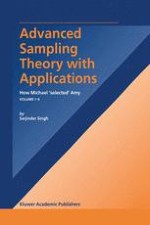2003 | Buch
Über dieses Buch
This book is a multi-purpose document. It can be used as a text by teachers, as a reference manual by researchers, and as a practical guide by statisticians. It covers 1165 references from different research journals through almost 1900 citations across 1194 pages, a large number of complete proofs of theorems, important results such as corollaries, and 324 unsolved exercises from several research papers. It includes 159 solved, data-based, real life numerical examples in disciplines such as Agriculture, Demography, Social Science, Applied Economics, Engineering, Medicine, and Survey Sampling. These solved examples are very useful for an understanding of the applications of advanced sampling theory in our daily life and in diverse fields of science. An additional 173 unsolved practical problems are given at the end of the chapters. University and college professors may find these useful when assigning exercises to students. Each exercise gives exposure to several complete research papers for researchers/students.
Anzeige
